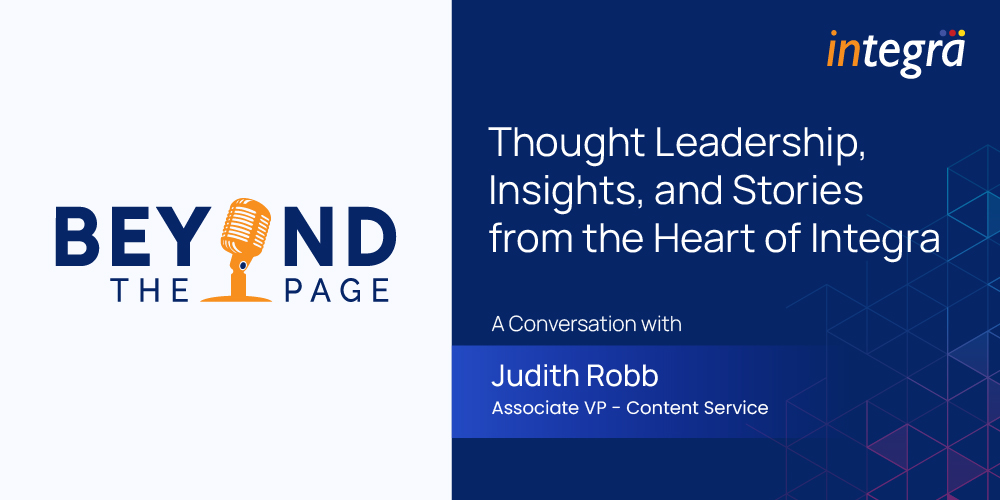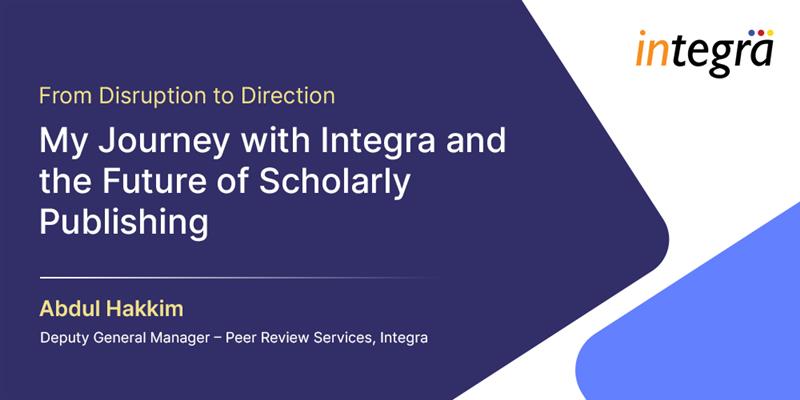Beyond the Page – Thought Leadership, Insights, and Stories from the Heart of Integra

Welcome to Beyond the Page, where we spotlight Integra’s leaders and changemakers who are shaping the future of content, technology, and education. Through candid conversations, we explore their perspectives on industry challenges, innovations, and how Integra is delivering on its promise to make publishing smarter and more human-centered.

Understanding the U.S. Education Market and Integra’s Strategic Approach
Judith, tell us about your journey and what led you to join Integra.
Judith: I’ve spent over two decades in the U.S. education publishing space, moving through roles that all share one common thread: a deep interest in how people learn. I’ve been an educator, writer, editor, curriculum lead, and later, a senior leader shaping editorial strategy. At the heart of it all is a belief that great content begins with great pedagogy.
My journey started as an educational consultant with the University of Chicago, collaborating on curriculum development. I then spent 15 years at Glenview School District 34 as a math and science teacher and later as a District Science Administrator. Those years taught me that education is not just about standards; it is about helping each student feel capable and curious.
Later, at Pearson, I worked on the K–2 enVision Math program, where I saw how thoughtful design could make complex concepts intuitive for young learners. That experience showed me how editorial choices can make learning personal.
What drew me to Integra was the opportunity to bring that sense of purpose into scalable systems, blending editorial rigor with operational excellence. As Associate Vice President and Head of U.S. Operations, I help clients navigate large-scale content challenges while staying true to one idea: every process and every page should ultimately serve the learner.
How does Integra support education publishers in the U.S. market?
Judith: We serve as an extension of our clients’ editorial and production teams, helping them create curriculum-aligned content for K-12, Higher Ed, and ELT segments. Our teams handle standards alignment, content development, instructional design, copyediting, fact-checking, and digital-first delivery formats.
What sets Integra apart is our ability to combine deep domain expertise with production scalability and technology-led workflows. Every project begins with understanding the learning intent behind the content, not just the process that delivers it. Our role is to help publishers bring pedagogy and practicality together so what we create is both accurate and meaningful for the learner.

Editorial Rigor Meets Operational Scale
What are some of the biggest challenges your clients face today?
Judith: The most pressing challenges revolve around scale and speed. Publishers are under pressure to deliver more content across multiple platforms, with tighter timelines and budgets. At the same time, they must maintain pedagogical rigor, meet accessibility guidelines, and adapt to evolving state and national standards.
The real challenge is balancing efficiency and authenticity. Educational content must not only be accurate but also emotionally and cognitively engaging. Publishers are looking for ways to meet aggressive schedules without losing the care and purpose that make learning meaningful. That is where our work begins—helping them achieve scale without sacrificing quality or the learner’s experience.
What makes Integra well-positioned to address these issues?
Judith: Our editorial operations are built to handle high-volume, standards-aligned content development without compromising quality. We have experienced U.S.-based and global subject matter experts, curriculum designers, and editors. Combined with structured workflows and technology integration, we help publishers meet demanding schedules while reducing overhead.
What truly positions us well is the way we combine scale with sensitivity. Every process is designed to preserve the learning intent. Our editors and instructional designers think like educators first, ensuring that technology and workflow never overshadow the human purpose of the content. This balance of rigor and empathy allows us to deliver efficiency that feels thoughtful, not mechanical.
You often talk about “humanizing” content. What does that mean in your context?
Judith: It means making content relatable, inclusive, and reflective of diverse learners. We ensure that material is culturally sensitive, accessible, and pedagogically sound. Whether it is reading level optimization, representation in visuals, or tone of voice, our teams work with intention so educational materials feel engaging and authentic.
Humanizing content goes beyond representation or compliance. It is about restoring trust between learners and material so every student feels seen, capable, and motivated to learn. When content acknowledges how children think and feel, not just what they need to know, it becomes a bridge between curiosity and confidence.

Leveraging Technology While Honoring Editorial Integrity
How is technology, especially AI, influencing your work in educational content development?
Judith: AI is changing the landscape in exciting ways, from automating quality checks to generating content drafts and supporting editorial tagging. But editorial oversight remains crucial. We use AI to enhance efficiency, but we rely on human judgment to maintain quality, voice, and educational intent. It is a blend of machine-driven speed and human editorial sensibility.
For me, technology is at its best when it amplifies human intention. AI allows us to streamline processes and accelerate delivery, but it should never override the empathy, insight, and context that experienced editors bring to the table. Our approach is to let AI do what it does best—analyze, organize, and accelerate—while people do what only they can: interpret, teach, and shape meaning.
Can you share an example of how Integra is using AI in real-world editorial workflows?
Judith: Absolutely. We are using AI to accelerate content mapping to state standards, auto-suggest alt text for accessibility, and improve version tracking. These tools drastically reduce turnaround times for large-scale curriculum projects. However, our editors always review and fine-tune the output to ensure it meets learning goals and style expectations.
What’s powerful about these tools is not just the speed they bring but how they allow editors to focus on what really matters: clarity, accuracy, and the learner’s experience. AI handles the repetition, while people bring insight, empathy, and intent. When technology and editorial judgment work together, the result is content that feels both precise and alive.

Looking Ahead: The Evolving Role of Editorial Strategy
What trends do you see shaping the future of educational publishing in the U.S.?
Judith: A few key shifts stand out: the growing demand for personalized and adaptive content, a stronger focus on inclusive and culturally responsive pedagogy, and higher expectations for digital content quality and accessibility. There is also rising interest in sustainable publishing—producing more with less waste, both digitally and operationally.
What’s emerging is a closer connection between technology and empathy. The industry is moving from simply delivering content to creating experiences that respond to how each learner thinks, feels, and learns.
AI-enabled learning ecosystems will be a key enabler that could make the above shifts possible.
The next phase of educational publishing will be defined by how authentically it combines innovation with humanity.
And what excites you about Integra’s role in this future?
Judith: Integra sits at a powerful intersection of people, process, and purpose. We’re building future-ready editorial teams, investing in technology, and deepening client partnerships. What excites me most is seeing how our work directly improves learning—whether it is the accuracy of a math problem or the relevance of a reading passage.
We are part of a larger movement toward education that feels personal and connected. Integra’s role is to bring structure and scalability to that vision while keeping innovation sustainable, pedagogy-driven, and human at its core.

Final Thoughts
Any advice for education publishers as they navigate this transformation?
Judith: Build strong partnerships. Find vendors who understand not just production, but pedagogy. Leverage AI and technology where it adds value, but stay anchored in the “why” behind your content. And don’t lose sight of your audience — today’s learners need content that reflects their world and supports their growth.
My advice would be to stay curious and stay human. The tools and timelines will always change, but the heart of education remains the same: connection, relevance, and trust. Publishers who hold on to that while embracing innovation will create learning experiences that not only inform but inspire.

Conclusion
Judith Robb’s perspective underscores Integra’s mission to make learning more personal, purposeful, and inclusive. Her approach reflects the belief that editorial excellence is not just about precision or process, but about empathy that shapes real learning moments.
Through her leadership, Integra continues to bring structure to creativity, blending scale with sensitivity and innovation with integrity. As the education landscape evolves, Judith and her team are helping publishers in building content ecosystems that listen, adapt, and grow with every learner.
Stay tuned for more episodes of Beyond the Page, where we continue exploring the ideas, people, and possibilities shaping the next chapter of educational publishing.
Recent Blogs

From Disruption to Direction: My Journey with Integra and the Future of Scholarly Publishing

AI–Human Collaboration Will Redefine Education Design and Publishing in 2026


